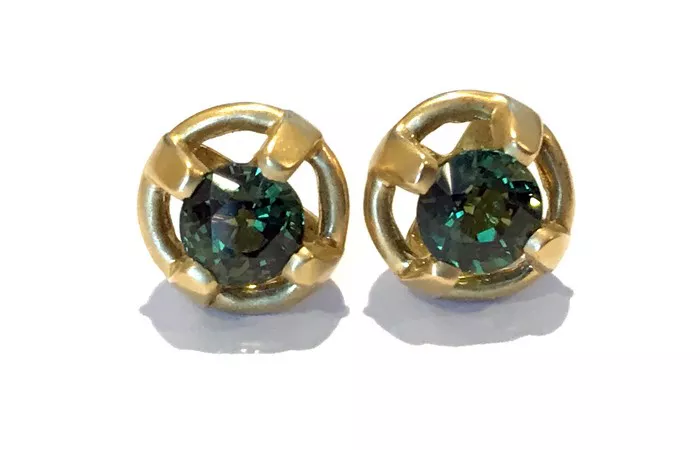Diamond stud earrings are a classic jewelry staple, prized for their timeless elegance and versatility. Whether worn casually or for formal occasions, they add a touch of sparkle and sophistication to any outfit. However, determining the right size of diamond studs can be a daunting task, as personal preferences, style considerations, and practicality all come into play. This comprehensive article explores the factors to consider when choosing diamond stud earrings, delving into what sizes might be considered “too big” and guiding you towards finding the perfect fit.
Understanding Diamond Stud Earrings
Diamond stud earrings consist of two diamonds set in metal posts that are worn close to the earlobe. Their simplicity and understated glamour make them a popular choice for everyday wear as well as special occasions. When discussing the size of diamond studs, several factors influence perceptions of size:
Carat Weight vs. Millimeter Size:
Diamonds are measured in both carat weight (which indicates the diamond’s weight) and millimeter size (which indicates the diameter of the diamond when viewed from above). Different diamond shapes and cuts can affect how large a diamond appears for a given carat weight.
Face-up Appearance:
The face-up appearance of a diamond, or how it looks when viewed from the top, is crucial in determining its perceived size. Diamonds with shallower cuts may appear larger face-up compared to deeper cuts of the same carat weight.
Personal Style and Comfort:
Personal preferences play a significant role in selecting diamond studs. Some individuals prefer smaller, more subtle earrings, while others gravitate towards larger, statement-making studs that catch the eye.
Factors Influencing Size Preferences
Choosing the right size of diamond studs involves considering several key factors:
Lifestyle and Daily Wear:
Individuals with active lifestyles or professions may prefer smaller diamond studs that are less likely to snag on clothing or get caught during physical activities. Larger studs might be reserved for special occasions.
Facial Proportions and Features:
The size of diamond studs should harmonize with the wearer’s facial features and ear size. Earrings that are too large or too small in proportion to the face may appear disproportionate or overwhelming.
Fashion Trends and Personal Taste:
Fashion trends can influence preferences for diamond stud sizes. While some may prefer timeless, smaller studs that never go out of style, others may opt for larger studs that make a bold fashion statement.
See Also: What Do Diamond Stud Earrings Say About You?
Assessing What Size is “Too Big”
Determining what size of diamond studs is considered “too big” is subjective and varies based on individual preferences and style. However, several considerations can help gauge whether a particular size might be overwhelming:
Proportion to the Earlobe:
Diamond studs that extend beyond the earlobe or overpower the natural shape of the ear may be perceived as too large. Studs should enhance, rather than dominate, the ear’s appearance.
Comfort and Wearability:
Overly large diamond studs can be heavy and uncomfortable for prolonged wear. They may also cause the earring to droop forward, affecting their aesthetic appeal.
Professional Settings and Occasions:
In professional environments or formal occasions where subtlety is valued, excessively large diamond studs might be considered inappropriate or distracting.
Finding the Balance: Choosing the Right Size
When selecting diamond stud earrings, it’s essential to strike a balance between personal style preferences and practical considerations:
Try Before You Buy:
Trying on different sizes of diamond studs allows you to see how they look against your ear and assess their visual impact. Many jewelers offer the option to try earrings in-store before making a purchase.
Consider Face Shape and Hairstyle:
Different face shapes and hairstyles can influence how diamond studs are perceived. For example, individuals with shorter hair or hairstyles that expose the ears may prefer larger studs for added visibility.
Consult with a Jeweler:
Experienced jewelers can provide valuable insights based on their expertise in diamond selection and earring design. They can help you navigate the trade-offs between size, quality, and budget.
Price Considerations and Value
The price of diamond studs increases with their size, quality, and the precious metal used in their settings. Factors to consider include:
Diamond Quality:
Diamonds with higher clarity and color grades command higher prices. Balancing quality with size ensures that you get the best value for your budget.
Metal Setting:
The choice of metal for the earring setting (such as platinum, white gold, yellow gold, or rose gold) affects both the aesthetic appeal and overall cost of the diamond studs.
Long-term Investment:
Diamond studs are often viewed as an investment piece due to their enduring appeal and potential to retain value over time. Choosing a size that aligns with your style and lifestyle ensures long-term satisfaction with your purchase.
Conclusion
Selecting the right size of diamond stud earrings involves careful consideration of personal style, practicality, and aesthetic preferences. While there is no definitive answer to what size is “too big,” understanding the factors that influence earring size can guide you towards making a confident and informed decision. Whether you opt for petite, subtle studs or larger, more striking earrings, diamond studs are a timeless accessory that adds a touch of brilliance to any wardrobe, reflecting your individuality and sense of style.
In conclusion, the quest for the perfect pair of diamond stud earrings is a journey that balances beauty with practicality, elegance with personal expression. By exploring the nuances of diamond sizes and understanding their impact, you can discover earrings that not only complement your features but also embody the enduring allure of diamonds in their purest form.

